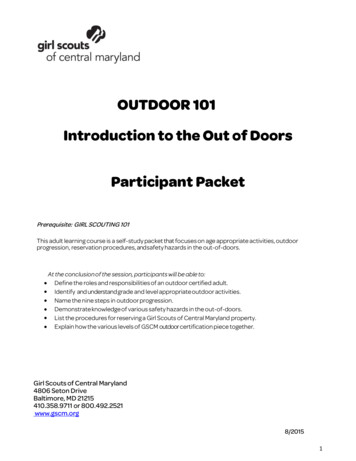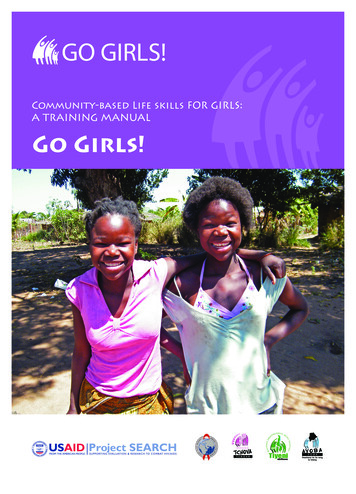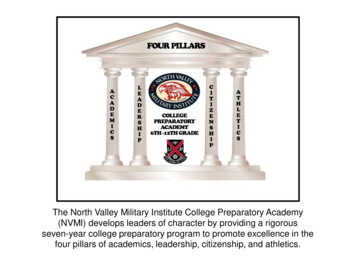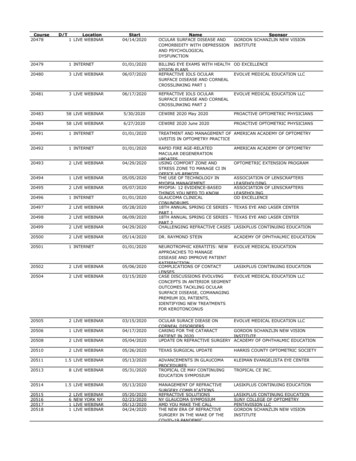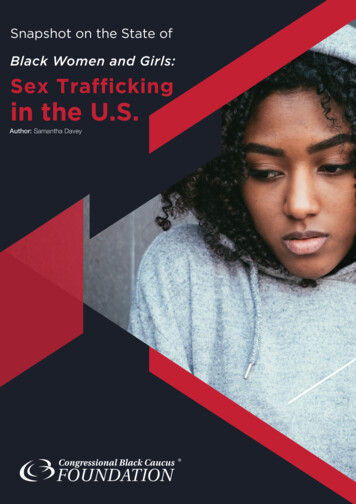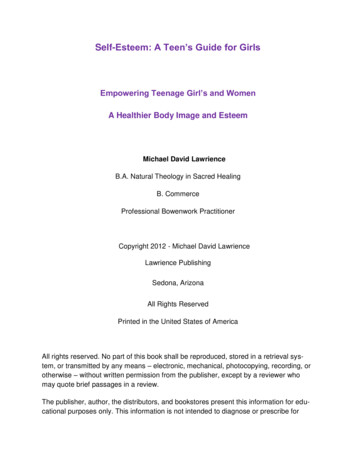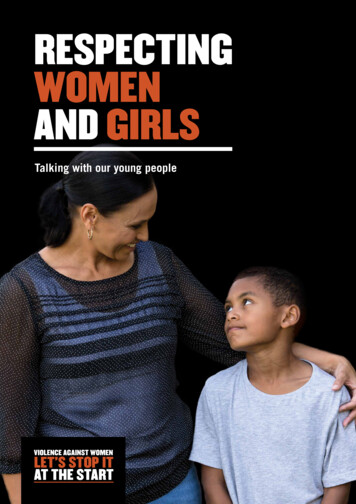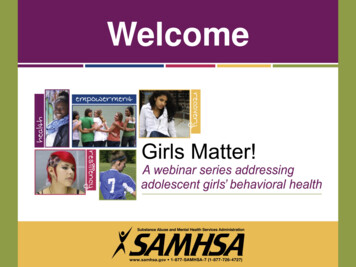
Transcription
Welcome
Deborah WernerDeborah WernerProject DirectorSAMHSA’s TA andTraining on Women andFamilies Impacted bySubstance Abuse andMental Health Problems
Technical Information Your lines will be muted for theduration of the call. If you experience technical difficultiesduring the webinar, pleaseemail Noah Shifman atnmshifman@ahpnet.com
Logistics Questions may be submitted by typing them intothe questions box. To open the question box –click the go-to menu (4 small boxes on right). Today’s webinar is being recorded and will beposted online. At the end of this webinar, is a quick feed-backsurvey. Please take a few minutes to give usfeedback.
CEU Information NAADAC and NBCC CEU are available for thiswebinar by the Addiction Technology Transfer CenterNetwork (ATTC) Coordinating Office. In order to receive CEU credits the webinar screenmust be primary for the duration of the webinar. If you are watching with a group, type the first and lastname of each participant along with the email addressinto the questions box now. You must do this in orderto get credit. (If you registered and are alone – do notchat your information.)
Disclaimers This webinar is supported by the SubstanceAbuse and Mental Health Services Administration(SAMHSA) and the U.S. Department of Healthand Human Services (DHHS). The contents of this presentation do notnecessarily reflect the views or policies ofSAMHSA or DHHS. The webinar should notbe considered a substitute for individualizedclient care and treatment decisions.
About Girls Matter!
Purpose of Girls Matter! Increase the behavioral healthworkforce’s understanding of theneeds and concerns of adolescentgirls (primarily ages 12-18) Bring visibility and attention to thespecific behavioral health concernsof adolescent girls
Webinars Growing Up Girl — February 25 Girl in the Mirror — March 13 Girls and Substance Use — April 22 Digital Girls — May 20 Sanctuary and Support — June 10 Youth Development andRecovery Supports — July 24
ModeratorTRINA MENDEN ANGLIN,M.D., PH.D.,HUMAN RESOURCE SERVICESADMINISTRATION (HRSA)
PanelistsScyatta Wallace, Ph.D.St. John’s UniversityElizabeth Miller, M.D., Ph.D.Children’s Hospitalof Pittsburgh of UPMC
Adolescent MedicineThe Health and Well-being ofAdolescent Girls:A Developmental PerspectiveElizabeth Miller, MD PhDDivision of Adolescent MedicineChildren’s Hospital of Pittsburgh of UPMC
Adolescent MedicineObjectives1. Describe typical adolescent femaledevelopment2. Identify key health issues affectingadolescent girls
AdolescenceAdolescent Medicine Transition between childhood and adulthood The interval between the beginning of sexualmaturation and the attainment of adult roles andresponsibilities in society––––Begins with physiologic changesAdult status is a social not biologic definition11- 26 yearsSocioculturally defined
PubertyAdolescent Medicine Sequence of events by which a child istransformed into an adult, including the growth ofsecondary sexual characteristics, the onset ofreproductive function, and dynamic brainchanges. Puberty and adolescence are separate processes– Puberty happens relatively early– Adolescence develops slowly and has a long tail
Adolescent MedicineFEMALESSequence andmean age ofpubertal events
Probit plots for age at menarchefor non-Hispanic white, non-Hispanic black,and Mexican American girls in the NHANES III.Chumlea W C et al. Pediatrics 2003;111:110-113 2003 by American Academy of PediatricsAdolescent Medicine
Neuroscience and the Teen BrainAdolescent Medicine
Phases andtasks of adolescenceAdolescent Medicine Early adolescence - 11-14 years (middle school) Middle adolescence - 15-18 years (high school) Late adolescence - 19-26 years (young adult)
Biopsychosocialdevelopment IndependenceBody imageCognitive developmentSexual developmentPeer group involvementIdentity and GoalsAdolescent Medicine
IndependenceAdolescent Medicine Early– Less interest in parental activities– Wide mood swings Middle– Peak of parental conflicts Late– Reacceptance of parental advice and values
Body image Early– Preoccupation w/ pubertal changes– Uncertainty about attractiveness Middle– General acceptance of body– Attention to appearance Late– Acceptance of pubertal changeAdolescent Medicine
Cognitive development Early– Concrete thought– Egocentrism Middle– Acquire abstract thought– Development of insight Late– Improved ability to verbalize ideas– Better able to appreciate alternativesAdolescent Medicine
Sexual development Early– Focus on body changes– Attractions emerge Middle– More intense sexual feelings– Pairings begin Late– Less fluctuation in pairings– More stable relationships– Emergence of sexual identityAdolescent Medicine
Peers Early– Intense relationships with friends Middle– Peak of peer involvement– Conformity with peer values– Sexual activity / experimentation Late– Peer group less important– Develop intimate relationshipsAdolescent Medicine
Identity and goalsAdolescent Medicine Early– Need for privacy– Idealistic vocational goals Middle– Feel omnipotent and immortal (“optimistic bias”)– Increased intellectual ability Late– Realistic vocational goals– Refinement of moral, religious, and sexual values
Adolescent MedicineWhat contributes to poor healthoutcomes among adolescent girls?
Mortality 12-19 year oldsAdolescent Medicine
Adolescent MedicineHomicide Rates Among Females Ages 10–24 Years, byRace/Ethnicity and Mechanism, United States, outhviolence/stats at-a glance/hr female.html
Depression and suicideAdolescent MedicineAmong US high school female students in past 12 months:– 36% reported feeling sad or hopeless almost every day for 2or more weeks in a row– 19% seriously consider attempting suicide– 15% had made a plan about suicide– 10% made a suicide attempt– 3% made an attempt that required medical attention (injury,poisoning, or overdose)– Sex differences in mortality related to suicide attempt(males females)YRBS 2011
Adolescent Medicine
Percentage of High School StudentsWho Ever Smoked Cigarettes,* by Sex andRace/Ethnicity,† 2009Adolescent aleMaleWhite43.540200* Ever tried cigarette smoking, even one or two puffs.†H BNational Youth Risk Behavior Survey, 2009BlackHispanic
Percentage of High School StudentsWho Ever Drank Alcohol,*by Sex† and Race/Ethnicity,‡ 2009Adolescent 0TotalFemaleMale* Had at least one drink of alcohol on at least 1 day during their life.†F M‡ W, H BNational Youth Risk Behavior Survey, 2009WhiteBlackHispanic
Percentage of High School StudentsWho Ever Used Marijuana,*by Sex† and Race/Ethnicity,‡ 2009Adolescent ispanic35.7200TotalFemale* Used marijuana one or more times during their life.†M F‡ B, H WNational Youth Risk Behavior Survey, 2009MaleWhite
Percentage of High School Students WhoEver Had Sexual Intercourse, 1991 – 2009†Adolescent 47.82001 200320052007 200945.646.0402001991 1993†19951997 1999Decreased 1991–2009, p 0.05.National Youth Risk Behavior Surveys, 1991–2009
Estimated Youth STI IncidenceAdolescent MedicineCDC STD Webinar on Adolescent Sexual Health 6/2011
Birth rates per 1,000 females ages15-19, by race/ethnicity, 1990-2012Adolescent MedicineSource: Hamilton, B. E., Martin, J. A., & Ventura, S. J.(2013). Births: Preliminary data for 2012. Hyattsville,MD: National Center for Health Statistics.87% of pregnancies among girls ages 15-17are unplanned
Prevalence of obesityAdolescent Medicine
ModeratorTRINA MENDEN ANGLIN,M.D., PH.D.,HUMAN RESOURCE SERVICESADMINISTRATION (HRSA)
Scyatta A. Wallace, Ph.DAssociate ProfessorSt. John’s UniversityCEO/FounderJanisaw Company
Adolescent girls are affected by many thingsduring their development including :-Self-Esteem/Identity-Parent & Family Relationships-Peer Pressure-School & Community Context-Racial and Cultural Influences
Identity Development The process of the development of the distinctpersonality of an individual. Defines individuals to others and themselves. Influenced greatly by interactions with others intheir immediate environment and larger society. Due to increased cognitive abilities andindependence, adolescents start focus more ondeveloping their self-identity.
Self-Identity Descriptive and evaluativerepresentations about the selfSelf-Esteem The judgment a person makes abouthis/her own worth
Self-esteem began todecline at age 11 yearsin white girls, butappeared to be stablein black girls between9 and 14 years of age.Figure 1 Global self-worth, by race and age. Longitudinalanalysis of 1213 black and 1166 white girls, aged 9 and 10years at intake. Black diamonds black participants; graysquares white participants.Biro, Striegel-Moore, Franko, Padgett & Bean, 2006
High levels of self-esteem are associatedwith positive outcomes in academicachievement, social relationships andimproved coping skills .Low levels of self-esteem can lead toadverse outcomes such as depression,anti-social behavior , substance abuseand eating disorders.(Biro, Striegel-Moore, Franko, Padgett & Bean, 2006)
Parents have the responsibility to both promoteadolescent development and adjustment and tointervene effectively when problems arise.("Maternal, newborn, child," 2014 )
Adolescents may start to notice the flawed, humanside of authority figures such as parents and otherfamily members.With newly found independence teenagers oftenquestion parents’ rules and may cause periods ofconflict.Adolescent girls try to test new roles to achieve newidentity, and parental authority may be severelytested.(Conger, Williams, Little, Masyn&Shebloski, 2009;Relationship development , 2014))
Parenting practices that support adolescent girls: Positive Interactions Show affection, love and respect to child Spend time with their child and enjoy family activities together. Supervision & Monitoring Engage child in straight talk about making healthy choices. Set clear boundaries and have clear, appropriateconsequences. Reinforcement Recognize hard work and achievements. Listen to their child’s concerns and opinions.
Peers serve as a referencegroups (e.g. cliques & crowds)with whom one comparesoneself. Peer groups may have positiveand negative effects.Teen friendships serve sixfunctions:CompanionshipStimulationPhysical SupportEgo SupportSocial comparisonAffection & intimacy(Mustillo , Budd & Hendrix, 2013)
“I would have to say my nine-year-old sister, to tell youthe truth, because she’s, like, the realest. I think she’s theone who really cares about me no matter what, who wouldnot judge me no matter what. She will always stick by myside, no matter what. Even when I’ve done wrong, she willstill be, like, “I still love you. I’m not gonna tell Mommy.You still good. I still love you.” She keeps me grounded.”- 17 year old female“I’m very careful about who I call my friends. So thefriends that I have now they’re good. We talk abouteverything; they support one another. They’re good.”- 15 year old female-Findings from R25 MH067127 and R25 HD045810 as part of theUCSF Collaborative HIV Prevention Research in MinorityCommunities
During adolescence social relationships withpeers become more important than parents.Peers provide the opportunity to compare andevaluate opinions, abilities, and physicalchanges.They may also create pressure for girls toengage in unhealthy behaviors such asdrugs/alcohol, disordered eating and unsafesex.(Conger, Williams, Little, Masyn&Shebloski, 2009 ;Mustillo , Budd & Hendrix, 2013)
“When I was in junior high school, there was this girl in class andshe was always reading these -– these books. Like, PUSH andZANE and stuff. And we was like, “What are those books about?”We snuck into her book bag and we read it one day, and it waslike, a whole new world. Like, “What is goin’ on? Do people reallydo this?”“ And people have been caught in my junior high school havin’sex. We caught a girl and a boy in the main staircase, whereeverybody comes. We were just like, “Wow. This is what peoplehave been doin’?” I was like, “Oh, shoot.” In junior high school.”- 17 year old female-Findings from R25 MH067127 and R25 HD045810 as partof the UCSF Collaborative HIV Prevention Research in MinorityCommunities
Gender Identity An inner sense of one’s self as masculine orfeminine, male or female Gender Roles How each sex is subject to different expectationsand pressures, which results in feminine ormasculine behaviors and attitudes
Gender Roles During adolescence girls’ self views are shaped bysocietal pressures to behave in ‘feminine ‘ ways. Expectations of “femininity” include :- remaining passive and avoiding conflict- suppressing anger- conforming with beauty images- being “nice “, lady like or ‘good’(Tolman, Impett, Tracy & Michael , 2006 ; Impett, Henson, Breines, Schooler&Tolman, 2011)
Level of voice term originating from the work of Carol Gilligan(1982,1993) adolescent girls may begin identifying with and endorsingthe cultural roles of the “good woman”: puts her others’ needs, desires and wants ahead of hers suppresses her own voice Previous studies suggest that girls with high levels offemininity exhibited lower levels of voice in publicsituations (school, outings with friends) than they did inprivate settings (at home).(Horn , Newton & Evers, 2011)
Racial Identity Knowledge about racial identity begins at age three,when children are able to perceive similarity with theirown racial/ethnic group However, it is not until adolescence that minority youthbegin to examine the meaning of their race and minoritystatus High levels of racial Identity are associated with positiveyouth outcomes
Acculturation The process of developingmultiple group identities,such as an “ethnic” identityas well as a “mainstream”identity. The “mainstream” identity isrelated to being a memberof the larger society (e.g.‘American’ culture). Among immigrant youth, acombination of strong“ethnic” identity and strong“mainstream” identity isrelated to healthydevelopmental outcomes
Rideout , Foehr & Roberts , 2010
Media outlets such as TV,magazines, and the socialmedia display the newesttrends in popular culturesuch as clothing styles,language and music.Girls are major consumers ofmedia and engage with thesemessages every day to “fit in”within their peer groups andsociety.(Report of the APA Task Force on the Sexualization ofGirls , 2007 )
Many media outlets sexualize women and girlsA Kaiser Family Foundation study found a 400% increase over a20 year period in sexual references during the evening televisionviewing time period commonly referred to as "family hour.“These sexualized images ‘teach’ girls thatwomen are objects and their value is based onimage/bodies. This can be detrimental to the development of selfconcept and world view when girls internalize thesenegative and unrealistic stereotypes.(Report of the APA Task Force on the Sexualization of Girls , 2007 )
When they are encouraged to love and take care of theirbodies without comparing or trying to conform to imagesfrom the media or societal expectations , girls develop astronger sense of self-esteem.
School connectedness appears especiallyimportant to adolescent girls who experienceadversity in their homes.School may be one of few contexts where suchachievements are recognized and celebrated .
Several studies have shown the benefits and effectsof involvement in extracurricular activities,religious communities and volunteering. Zaff and colleagues discovered that consistent participationin extracurricular activities from 8th grade through 12thgrade predicted academic achievement and prosocialbehaviors in young adulthood.(Zaff, Moore, Papillo& Williams, 2003; Lenzi, Vieno, Santinello,Nation & Voight, 2013 )
What is there for teens to do in your neighborhood?“There’s a library across the street but even the library looksbad. Lets see you have a broken down park, that people stayafter dark and I think people have been shot there. My oldprivate school they messed up the basketball courts, mind youthe school had gates and dogs but they still find a ways to jumpand play basketball and break the hoops and all that stuff.Library, library is a mess, they mess up the books. Look likesomebody threw a bomb there.”– 16 year old female-Findings from R25 MH067127 and R25 HD045810 as part of the UCSFCollaborative HIV Prevention Research in Minority Communities
Resiliency is the ability to adapt well in theface of challenging circumstances.Resiliency can be nurtured and supported bycaring adults who take a strength-basedapproach to foster and empower a child’sefforts to cope with hardships.In the case of adolescent girls, developing ahealthy self- esteem and having good rolemodels protects from risk factors.("Girls study group," 2009;Alvord ,Gurwitch, Martin&Palomares, 2011) )
Adolescent girls dependon their families,communities, schools,health services and theirworkplaces to learn awide range of importantskills that can help themcope with the pressuresthey face and make thetransition fromchildhood to adulthoodsuccessfully.("Maternal, newborn, child," 2014 )
Dear Mary J,I love you so much you are like a hero to me. As a child I hated myselfbut whenever I listened to your music I feel inspired. My name is X. I’ma 13 year old in the 9th grade. At this moment I have started writing abook about fake friends because all my life I never had a close personto lean on.Your group FFAWN have helped me in many ways. I was able to meetnew people and learn about other teenagers. I have changed a lotsince I’ve been going to this girls group. I was able to become closewith other teenagers my age and even older than me.I thank you so much for creating this girls group to help out otherteenager girls. And for this I love you so much. You are one of a kind.-Letter from participant of FFAWN 3E workshops
The Representation es/Dove Self-Esteem steem/GetInvolved/Communication Skills Building for Parents of Preteen ns/True Childhttp://www.truechild.org/FindTools
THANK YOU: Rose Aka, BA Psychology, Class of 2014 Sharon Amatetti at SAMHSA Substance Abuse & Mental Health Services AdministrationInformation for this presentation was supported by: SAMHSA / CSAP / Division Of Knowledge Application And Systems Improvement,Grant # 5 H79 SP10687 Heinz Endowments NIMH grant R25 MH067127 and NICHD grant R25 HD045810 as part of the UCSFCollaborative HIV Prevention Research in Minority Communities Program Heinz Endowments Foundation for the Advancement of Women Now (FFAWN)
Dept of PsychologySt. John’s Universitywallaces@stjohns.eduJanisaw Companywww.janisaw.comscyatta@janisaw.com
Alvord , M. K., Gurwitch, R., Martin, J., &Palomares, R. S. American Psychological Association , (2011).Resiliencefor teens :got bounce ? . Retrieved from website: http://www.apa.org/helpcenter/bounce.aspxAmerican Psychological Association,Task Force on the Sexualization of Girls. (2007). Report of the APA TaskForce on the Sexualization of Girls.Washington, DC:American Psychological Association. Retrieved fromwww.apa.org/pi/wpo/sexualization.htmlBiro, F. M., Striegel-Moore, R. H., Franko, D. L., Padgett, J., & Bean, J. A. (2006). Self-esteem in adolescentfemales. Journal of Adolescent Health, 39(4), 501-507. Conger, K. J., Williams, S. T., Little, W. M., Masyn , K. E.,&Shebloski, B. (2009). Development of mastery during adolescence : The role of family problem solving . JHealth Soc Behav, 50(1), 99-114.Horn , T. S., Newton, J. H., & Evers, J. (2011). Gender conceptualizations in female high school seniors:Relationships with global self-worth and multiple measures of body image. Sex roles , 65, 383-396. doi:10.1007/s11199-011-0028-zImpett, E. A., Henson, J. M., Breines, J. G., Schooler, D., &Tolman, D. L. (2011). Embodiment feels better: Girls'body objectification and well-being across adolescence . Psychology of Women Quarterly ,35(1), 46-58. doi:10.1177/0361684310391641Lenzi, M., Vieno, A., Santinello, M., Nation , M., &Voight, A. (2013). The role played by the family in shapingearly and middle adolescent civic responsibility. The Journal of Early Adolescence , 34(2), 251-278. doi:10.1177/0272431613485822Pipher, M. (1994). Reviving Ophelia: Saving the selves of adolescent girls. New York: Random House; 1994.World Health Organization, (2014 ). Maternal, newborn, child and adolescent health. Retrieved from website:http://www.who.int/maternal child adolescent/topics/adolescence/dev/en/Rideout , V. J., Foehr , U. G., & Roberts , D. F. The Kaiser Family Foundation Study , (2010). Generation m2 mediain the lives of 8-18 year olds. Tolman, D. L., Impett, E. A., Tracy, A. J., & Michael , A. (2006 ). Looking good ,sounding good :femininity ideology and adolescent girls' mental health.Psychology of Women Quarterly , 30,85-95.U.S. Department of Justice, Office of Juvenile Justice and Delinquency Prevention. (2009). Girls study groupunderstanding and responding to girls’ delinquency (NCJ 220124)Zaff, J. F., Moore, K. A., Papillo, A. R., & Williams, S. (2003). Implications of extracurricular activity participationduring adolescence on positive outcomes . Journal of Adolescent Research ,18(6), 599-630. doi:10.1177/0743558403254779
ModeratorTRINA MENDEN ANGLIN,M.D., PH.D.,HUMAN RESOURCE SERVICESADMINISTRATION (HRSA)
It’s Teen Dating ViolenceAwareness and Prevention MonthCreated byBRAVO of O’Neill
WHAT WE KNOWAdolescent Medicine1 in 4 (25%) U.S.womenand1 in 5 (20%) U.S. teengirls report everexperiencing physicaland/or sexual partnerviolence.
From “Teen Dating Violence” to“Adolescent Relationship Abuse”Adolescent Medicine Adolescence spans a LONG time (ages 10– 26) so interventions need to bedevelopmentally appropriate Opportunity for youth and young adults todefine diverse “relationships” – hanging out,hooking up, talking to someone Inclusive of range of abusive behaviors (notonly violence) -- including tech abuse
Adolescent Relationship Abuseis Prevalent One in four teens in arelationship report beingcalled names, harassed,or put down by theirpartner via cellphone/textingAdolescent Medicine One in five teen girlshave electronically sent orposted nude/semi-nudephotos or videos ofthemselves (12% ofthese girls say they felt‘pressured’ to do so)
Adolescent MedicineAdolescent Relationship Abuse is a PublicHealth Problem Sexual and reproductive health Mental health and substance use Overall health status
LACK OF CONTROL IN SEXUAL ENCOUNTERS“Adolescent MedicineI'm not gonna say he raped me. he didn't use force,but I would be like, "No," and then, next thing, hepushes me to the bedroom, and I'm like, "I don't want todo anything, " and then, we ended up doin' it, and I wascryin' like a baby, and he still did it. And then, afterthat. he got up, took his shower, and I just stayed therelike shock Miller, et al, 2007
Adolescent MedicineRelationship Abuse and Pregnancy Adolescent girls in physicallyabusive relationships are3.5 times more likely to becomepregnant than non-abused girls.
Adolescent MedicineRelationship Abuse and Pregnancy Adolescent mothers whoexperienced physical abuse withinthree months after delivery werenearly twice as likely to have arepeat pregnancy within 24 months
Adolescent MedicineRelationship Abuse andUnprotected Intercourse Girls who experienced physicaldating violence were 2.8 timesmore likely to fear the perceivedconsequences of negotiatingcondom use than non-abusedgirls
MALE PARTNER PREGNANCY INTENTIONAND CONDOM MANIPULATION“Adolescent MedicineLike the first couple of times, the condom seems tobreak every time. You know what I mean, and it wasjust kind of funny, like, the first 6 times the condombroke. Six condoms, that's kind of rare I couldunderstand 1 but 6 times, and then after that when I goton the birth control, he was just like always saying, likeyou should have my baby, you should have mydaughter, you should have my kid.”– 17 yr. old female who started Depo-Provera without partner’s knowledgeMiller, et al, 2007
BIRTH CONTROL SABOTAGE“Adolescent MedicineI was on the birth control, and I was still taking it, and heended up getting mad and flushing it down the toilet,so I ended up getting pregnant. I found out that[before this] he talked to my friends and he told themthat we were starting a family. I didn't know that. Ididn't want to start a family. I wanted to finish school.– 18 yr. old femaleMiller, et al, 2007with 2 year old son
Adolescent Medicine“I talk about this withall my patients ”Providing UniversalEducation onHealthy Relationships
Assessment orEducation?Adolescent Medicine Few adolescents report experiences ofviolence to adults, and adolescents make upa small proportion of clients utilizingdomestic violence services. (Foshee et. al, 2000) Goal may be education about relationshipabuse and that the adolescent healthprogram is a safe place to discuss theseissues
Adolescent MedicineFutures WithoutViolenceSafety Card forAdolescentRelationshipAbuse(Funding: DOJ andHHS, ACF and OWH)
Adolescent Medicine
Adolescent Medicine Opportunity to talk about healthyrelationships Provide primary prevention by identifyingSafety cards assigns of an unhealthy relationship.a simple, brief Educate clients about what they can do ifassessmentthey have a friend or family member whoand counselingmay be struggling with abuseintervention Plant seeds for adolescents experiencingabuse but not yet ready to disclose. Help victims learn about safety planning,harm reduction strategies and supportservices.
Adolescent MedicineClientperspectives“They would bring out a card, basicallywalk in with it and she would open itand ask me had I ever seen it before. .It was awesome. She would touch onhaving, no matter what the situationyou’re in, there’s some thing or someplace that can help you. I don’t have tobe alone in it. That was really huge forme because I was alone most of thetime for the worst part.”
Adolescent MedicineClientperspectives“[Getting the card] makesme actually feel like I have alot of power to helpsomebody ”Safety card available from Futures Without Violence
AcknowledgmentsAdolescent Medicine The Substance Abuse and Mental Health Services Administration(SAMHSA) Futures Without Violence Planned Parenthood Shasta-Diablo Affiliate; Planned ParenthoodWestern PA; Adagio Health California Adolescent Health Collaborative California School Health Centers Association Rebecca Levenson, Jay Silverman, Michele Decker,Heather McCauley, Daniel Tancredi, Jeff Waldman,Phyllis Schoenwald Catrina Virata, Heather Anderson, Rebecca Dick, Hillary Darville,Jill Etienne, Angela Hicks, Sarah Zelazny, Tarrah Herman, ClaireRaible, Sam Ciaravino, Janice Korn, Kelley Jones, Laura YantzFunding: William T. Grant Foundation, BIRCWH, NICHD, DOJ,CDC, Nike Foundation, Waitt Institute for Violence Prevention,DHHS Office on Women’s Health, National Institute of Justice,DHHS Administration for Children and Families
Adolescent MedicineTHANK YOU!
Closing Comments
Resources SAMHSA’s Girls Matter!http://www.tinyurl.com/girlsmatter2014 Other SAMHSA resources http://www.samhsa.gov HHS, Office of Women’s Health, girls health websitewww.girlshealth.gov HRSA Office of Women’s Health, health & wellnesshttp://www.hrsa.gov/womenshealth/wellness/ Futures without Violencehttp://www.futureswithoutviolence.org/
Resources continued Interagency Working Group on Youth Programs,collaborative website http://findyouthinfo.gov/ National Institute on Drug Abuse, teen websitehttp://teens.drugabuse.gov/ National Online Resource Center on Violence AgainstWomen, Teen Dating Violence Special s/TDV.php Federal collaborative website on bullyinghttp://www.stopbullying.gov/
THANK YOU! Following the webinar you will see a briefsatisfaction survey. Please take a moment toprovide your email address and feedback! All qualified attendees for today’s training will receive anemail from ceu@attcnetworkoffice.org within 72 hours oftoday’s event with instructions for obtaining yourcertificate of attendance We hope you enjoyed the presentation andthat you will join us for the Girl in the Mirror onMarch 13th.
In order to receive CEU credits the webinar screen must be primary for the duration of the webinar . If you are watching with a group, type the first and last name of each participant along with the email address into the questions box now. You must do this in order to get credit. (If you registered and are alone - do not chat your .

